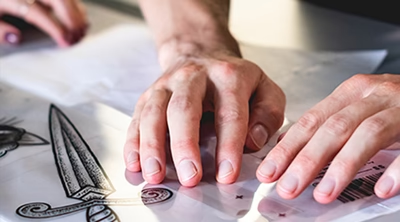What To Choose Traditional Stencils and Silk Screen Stencils: Know All The Differences
Are you looking to enhance your design skills or just beginning your journey into screen printing? One major challenge you might face is selecting the right screen printing stencil. But don't worry; we have gathered all the relevant information to help you make a correct decision without many issues. From scrutinising the materials used in traditional stencils to understanding the intricacies of the silk screen process, we've got you covered. Let's dive in and unravel the details.
Why Should You Choose Stencils for Printing on Fabric?
Stencils have been integral to artistic expression and practical applications for centuries. Whether used in art, crafts, or industrial settings, stencils provide a means of replicating designs with precision. While silk screens and traditional stencils serve similar purposes, they differ significantly in materials, methods, and the effects they achieve.
Difference Between Silk Screen and Traditional Stencils
Here are a few differences between silk screen and traditional stencil:
1. Materials and Composition:
Traditional Stencils:
Traditional stencils usually contain long-lasting materials like cardboard, plastic, or metal. These materials provide stability and are simple to shape using scissors, craft knives, or die-cutting tools. Traditional stencil materials are sturdy due to their thickness, making them suited for one-time or restricted use.
Silk Screen Stencils:
On the other hand, silk screen stencils are formed from fine mesh screens, which are frequently composed of silk, polyester, or nylon. The mesh is firmly stretched over a frame, creating a strong, flexible surface. The stencil design obstructs specified mesh sections while allowing ink or paint to pass through in precise patterns. Silk screen stencils are noted for their reusability and endurance compared to regular stencils.
2. Creation Process:
Traditional Stencils:
Creating traditional stencils involves manually cutting out the desired design from the stencil material. This process requires precision and attention to detail, as any errors in cutting will be reflected in the final result. Traditional stencils can be made by hand, making them accessible for many DIY projects.
Silk Screen Stencils:
The creation of these stencils is a more intricate process. It often involves using photosensitive emulsion or screen filler to block out areas of the mesh screen, leaving the design open for ink or paint application. The silk screen process allows for highly detailed and repeatable designs but requires additional tools and materials, such as a light source for exposing the emulsion.
3. Precision and Detail:
Traditional Stencils:
Traditional stencils are suitable for simpler designs and bold, straightforward shapes. Achieving intricate details may be challenging, especially when cutting by hand. The thickness of the stencil material can also restrict the level of detail that can be reproduced.
Silk Screen Stencils:
These stencils excel in capturing intricate details with precision. The fine mesh allows for sharp lines and small details to be reproduced accurately. This makes the stencils a preferred choice for artists and designers who seek a high level of detail in their work.
4. Versatility:
Traditional Stencils:
Traditional stencils are adaptable and may be used on plenty of materials such as paper, cloth, wood, and walls. However, the materials may need to adapt better to curved or uneven surfaces because they are unyielding.
Silk Screen Stencils:
Silk screen stencils are incredibly versatile. They may be utilized on flat or curved surfaces, making them useful for many applications ranging from printing T-shirts to generating elaborate patterns on irregularly shaped items.
5. Reusability:
Traditional Stencils:
Traditional stencils are generally intended for one-time or limited use. While they can be reused with care, the wear and tear on the stencil material may lead to a loss of precision over time.
Silk Screen Stencils:
Silk screen stencils are known for their durability and reusability. Proper cleaning and storage allow a silk screen DIY technique to be used for multiple projects without significantly declining quality. This makes them a cost-effective choice for artists and businesses engaged in repetitive design work.
Conclusion:
The manufacturing process, versatility, precision, and reusability of silk screens and traditional stencils diverge significantly. Traditional stencils boast simplicity and user-friendliness, enabling the creation of charming patterns and engaging DIY projects. Conversely, silk screen stencils offer a more intricate, adaptable, and enduring solution, making them the preferred choice for designers, businesses, and professional artists engaged in large-scale production.
The decision between traditional and silk screen stencils is contingent upon the project's requirements, the desired level of detail, and the intended use. Each stencil type carries its own set of advantages, and understanding their distinctions empowers artists and creators to make informed decisions tailored to their specific needs and preferences.


.jfif)
Comments
Post a Comment